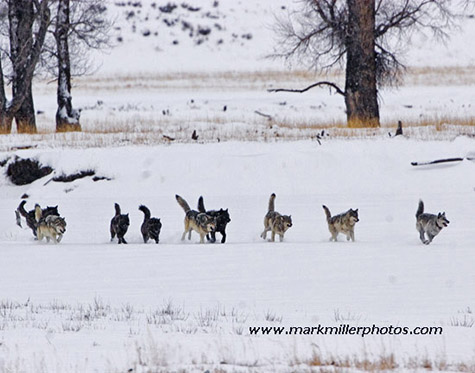Mark Miller, photographer in Gardiner, Montana, sent me a new photo of the Agate Creek Pack in the Lamar Valley. The one I posted recently had some cropping problems (on my end). Hopefully, this one is better.
Alpha Wolf 113M is the large gray wolf on the left side in front of a black wolf. Wolf 472F leads in the photo.
This is a very difficult kind of photo to get because it requires standing in the cold for a long time, and then composing quickly and snap the image.

Photo by Mark Miller. www.markmillerphotos.com
Comments
Excellent photograph, Mark. This is the best kind of wildlife photo, as it effectively conveys the animals within the context of the landscape. Beautiful.
Awesome photo. Mark – would you mind saying what type of lens you were using, how far the wolves were away and what the light was like (sun, clouds, etc)?
Am hoping sometime this winter that I might see some Idaho packs in a similar setting.
Seems 98% of the time when wolves appear it’s either early in the morning before sunrise, or the sun is shining right toward the camera, or it’s rainy/snowy/cloudy. Any advise you have on have to overcome such conditions to get a good pix would be appreciated.
Thank you.
Thanks all.
Lynne- you are certainly welcome to email me for more details: mjmphotos@yahoo.com
This photo came about from a very lucky opportunity that comes from many days outdoors. First, I want to be careful to not be where the wolves might be skittish because of my presence. Fortunately, we were in a pull-out, with other wolf watchers, distant enough from a carcass not to be a deterrent. The whole Agate Creek pack came running across the Lamar valley toward the carcass, unperturbed by our presence. At some 250-300 yards in this photo, the Agates were nicely lined up in front of the cottonwoods. The conditions were overcast, not too cold, in the morning. For this photo I manually follow-focused a 500mm Canon IS lens with a 2x converter on a Canon 20D body- an effective 1600mm. I shot fast shutter speeds and kept the camera steady. (A Canon 600mm IS on a 1dsMarkII body would have been ideal, but I didn’t notice one under the Christmas tree. So sad!) From experience, too, having a reasonable sense of understanding animal behavior is a plus. Hope that helps- Good luck!